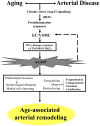Arterial aging: a journey into subclinical arterial disease
- PMID: 20040868
- PMCID: PMC2943205
- DOI: 10.1097/MNH.0b013e3283361c0b
Arterial aging: a journey into subclinical arterial disease
Abstract
Purpose of review: Age-associated arterial alterations in cells, matrix, and biomolecules are the foundation for the initiation and progression of cardiovascular diseases in older persons. This review focuses on the latest advances on the intertwining of aging and disease within the arterial wall at the cell and molecular levels.
Recent findings: Endothelial dysfunction, vascular smooth muscle cell (VSMC) proliferation/invasion/secretion, matrix fragmentation, collagenization and glycation are characteristics of an age-associated arterial phenotype that creates a microenvironment enriched with reactive oxygen species (ROS) for the pathogenesis of arterial disease. This niche creates an age-associated arterial secretory phenotype (AAASP), which is orchestrated by the concerted effects of numerous age-modified angiotensin II signaling molecules. Most of these biomolecular, cell, and matrix modifications that constitute the AAASP can be elicited by experimental hypertension or atherosclerosis at a younger age. The arterial AAASP also shares features of a senescence-associated secretory phenotype (SASP) identified in other mesenchymocytes, that is, fibroblasts.
Summary: A subclinical AAASP evolves during aging. Targeting this subclinical AAASP may reduce the incidence and progression of the quintessential age-associated arterial diseases, that is, hypertension and atherosclerosis.
Conflict of interest statement
None
Figures
References
-
- Aging-dynamics of cancer. at http://www.cdc.gov/nchs/
-
- Humes K. The population 65 years and older: Aging in America. The book of the States. 2005:464–470.
-
- Lakatta EG, Wang M, Najjar SS. Arterial aging and subclinical arterial disease are fundamentally intertwined at macroscopic and molecular levels. Med Clin North Am. 2009;93:583–604. This is a comprehensive overview on the current knowledge on the intertwining of arterial aging and disease. - PMC - PubMed
-
- Lakatta EG. Central arterial aging and the epidemic of systolic hypertension and atherosclerosis. J Am Soc Hypertens. 2007;1:302–340. - PubMed
Publication types
MeSH terms
Substances
Grants and funding
LinkOut - more resources
Full Text Sources
Medical
Research Materials


